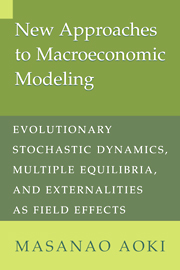 New Approaches to Macroeconomic Modeling
New Approaches to Macroeconomic Modeling Book contents
- Frontmatter
- Contents
- Preface
- Part I Introduction
- Part II Modeling Interactions
- Part III Hierarchical Dynamics and Critical Phenomena
- 7 Sluggish Dynamics and Hierarchical State Spaces
- 8 Self-organizing and Other Critical Phenomena in Economic Models
- Elaborations and Future Directions of Research
- Appendix
- References
- Index
Elaborations and Future Directions of Research
Published online by Cambridge University Press: 05 May 2010
- Frontmatter
- Contents
- Preface
- Part I Introduction
- Part II Modeling Interactions
- Part III Hierarchical Dynamics and Critical Phenomena
- 7 Sluggish Dynamics and Hierarchical State Spaces
- 8 Self-organizing and Other Critical Phenomena in Economic Models
- Elaborations and Future Directions of Research
- Appendix
- References
- Index
Summary
We collect here some items that are a further elaboration of topics discussed in the main body of this book, and to suggest potentially useful and important topics for the reader to develop further. We have consistently viewed dynamics as stochastic and we continue this view in this chapter as well.
One of the major aims of this book is to examine consequences of changing patterns of agent interaction over time. We view these patterns as distributions of agents over possible types or categories over time, and we endevour to discover stable distributions of patterns of interactions among agents.
Equilibrium distributions of patterns of classification describe stable emergent properties of the model. Some simple and suggestive examples are discussed in Chapters 4 and 5.
In models with a small number of types, choices or classes, the methods developed in Chapter 5 are quite effective. When the number of classes becomes large, (numerical) solutions of the master equations may become cumbersome. An attractive alternative is to examine equilibrium distributions directly. We outline this method in Section E.2 by drawing on the literature of population genetics and statistics.
Interactions among several types of large numbers of agents may sometimes be modeled as Markov processes on exchangeable random partitions of a set of integers. Aldous (1985) mentions J. Pitman for the name, “Chinese restaurant process” which models how a restaurant with a large number of initially empty tables is sequentially filled up as customers arrive.
- Type
- Chapter
- Information
- New Approaches to Macroeconomic ModelingEvolutionary Stochastic Dynamics, Multiple Equilibria, and Externalities as Field Effects, pp. 226 - 245Publisher: Cambridge University PressPrint publication year: 1996


